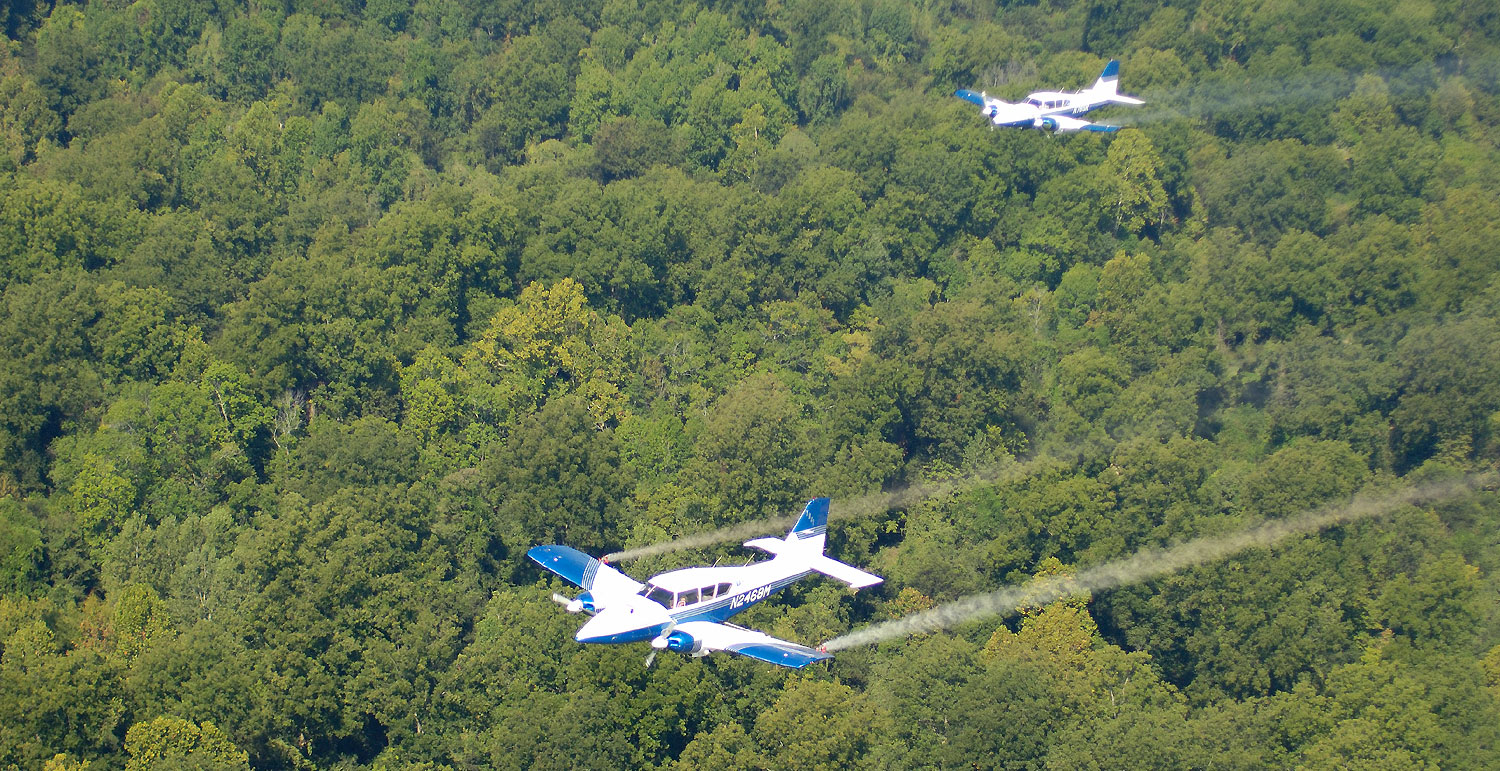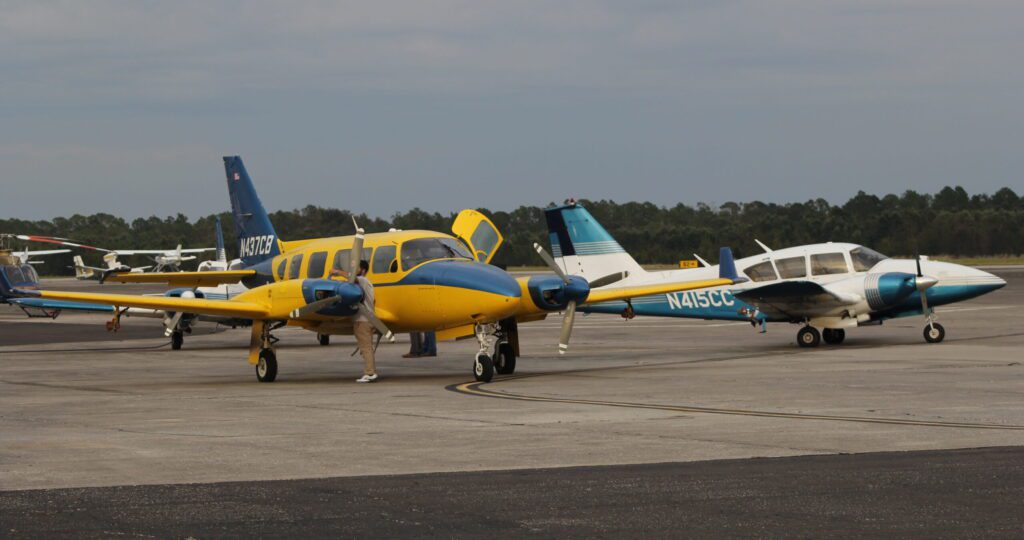Effectively and Safely Controlling Mosquito Populations
Aerial applications can be an important component of an Integrated Mosquito Management (IMM) program and are most often performed when the risk of vector-borne disease transmission is elevated. As municipalities and mosquito abatement districts gain a better understanding of the specific disease risks in their communities, our team continues to stay on the cutting edge of technology, utilizing fixed wing or rotary wing aircraft for each specific job to effectively target larval and adult mosquitoes.

As the owner of the largest fleet of aircraft in the world dedicated specifically to mosquito control, VDCI has been on the front lines combatting mosquito-borne diseases like West Nile virus and dengue. Each community we serve has unique needs and our team considers several factors before conducting an aerial application, including the species of the mosquito, the need for larval and/or adult mosquito control, the size and type of area to be treated, and whether the use of an airplane (fixed wing) or helicopter (rotary wing) is optimal.
VDCI is proud to have been working with the Sacramento-Yolo Mosquito and Vector Control District since 2005. We serve our partner with fixed wing aircraft that allow our teams to cover an extensive area that could be difficult to treat on the ground. Since the beginning of our partnership, our work there has expanded to surrounding counties. Today, VDCI supplies a dedicated fixed winged aircraft to Sac-Yolo and three additional contiguous counties of Placer, San Joaquin, and Stanislaus. In August, these counties began to see an increased presence of West Nile Virus in their mosquito populations and VDCI brought in additional aircraft to respond to the increased risk of disease transmission. In August alone, we treated 475,000 acres to control adult mosquito populations, which brought our total for the year to over 1.1 million acres in these California counties.
Fixed wing aircraft can provide benefits that include:
- The ability to treat areas that can sometimes be difficult or too large to treat on the ground.
- Breaking the mosquito breeding cycle after natural disasters where severe flooding occurs.
- Providing quick results to emergency response situations where a disease outbreak is present.

On the opposite side of the country, VDCI is working to combat the spread of Zika virus via our rotary wing capabilities. Our work in Broward County, Florida focuses on the application of Bacillus thuringiensis israelensis (Bti). Bti is a naturally occurring soil bacteria used as a biological control agent for larvae stages of mosquitoes. There are important differences in the application of Bti versus that of products used to control adult mosquitoes. Although fixed wing aircraft can be used to apply Bti, a rotary wing aircraft can often be a better choice depending on the parameters of the mission. In this specific instance, the benefits of using rotary wing capabilities include:
- More versatile landing and takeoff requirements. Helicopter loading zones are often closer to the spray blocks, decreasing ferry time, and increasing the actual application time.
- Ability to target smaller areas. Helicopters can readily treat blocks as small as 10 acres, whereas airplanes need larger block sizes to be effective due to their speed and altitude.
- Ability to make applications at slower flight speeds, along with the lower altitudes, allows a more precise application rate and deposition of product into the target zone.
- The rotors of a helicopter can actually serve as a means to ‘push’ the product down into the spray zone.
- Ability to turn quickly and maneuver within urban environments that contain many physical structures. This is extremely meaningful in combating the primary vector of Zika virus, the Aedes aegypti.
As a result of the above, VDCI was able to target and treat 4 square miles where there was an increased risk of Zika virus transmission. The mission was completed in six hours when there were very few residents outside.
VDCI has been providing aerial application services for over 20 years. Due to the complicated nature of these applications, very few companies possess the experience and capability to handle aerial larval and adult mosquito control. Our expertise, our technology, and reporting capabilities, are an asset to any program in need of aerial application services.
Contact Us to Learn More About Effective Mosquito Management Strategies:
 Since 1992, Vector Disease Control International (VDCI) has taken pride in providing municipalities, mosquito abatement districts, industrial sites, planned communities, homeowners associations, and golf courses with the tools they need to run effective mosquito control programs. We are determined to protect the public health of the communities in which we operate. Our mosquito control professionals have over 100 years of combined experience in the field of public health, specifically vector disease control. We strive to provide the most effective and scientifically sound mosquito surveillance and control programs possible based on an Integrated Mosquito Management approach recommended by the American Mosquito Control Association (AMCA) and Centers for Disease Control and Prevention (CDC). VDCI is the only company in the country that can manage all aspects of an integrated mosquito management program, from surveillance to disease testing to aerial application in emergency situations.
Since 1992, Vector Disease Control International (VDCI) has taken pride in providing municipalities, mosquito abatement districts, industrial sites, planned communities, homeowners associations, and golf courses with the tools they need to run effective mosquito control programs. We are determined to protect the public health of the communities in which we operate. Our mosquito control professionals have over 100 years of combined experience in the field of public health, specifically vector disease control. We strive to provide the most effective and scientifically sound mosquito surveillance and control programs possible based on an Integrated Mosquito Management approach recommended by the American Mosquito Control Association (AMCA) and Centers for Disease Control and Prevention (CDC). VDCI is the only company in the country that can manage all aspects of an integrated mosquito management program, from surveillance to disease testing to aerial application in emergency situations.

